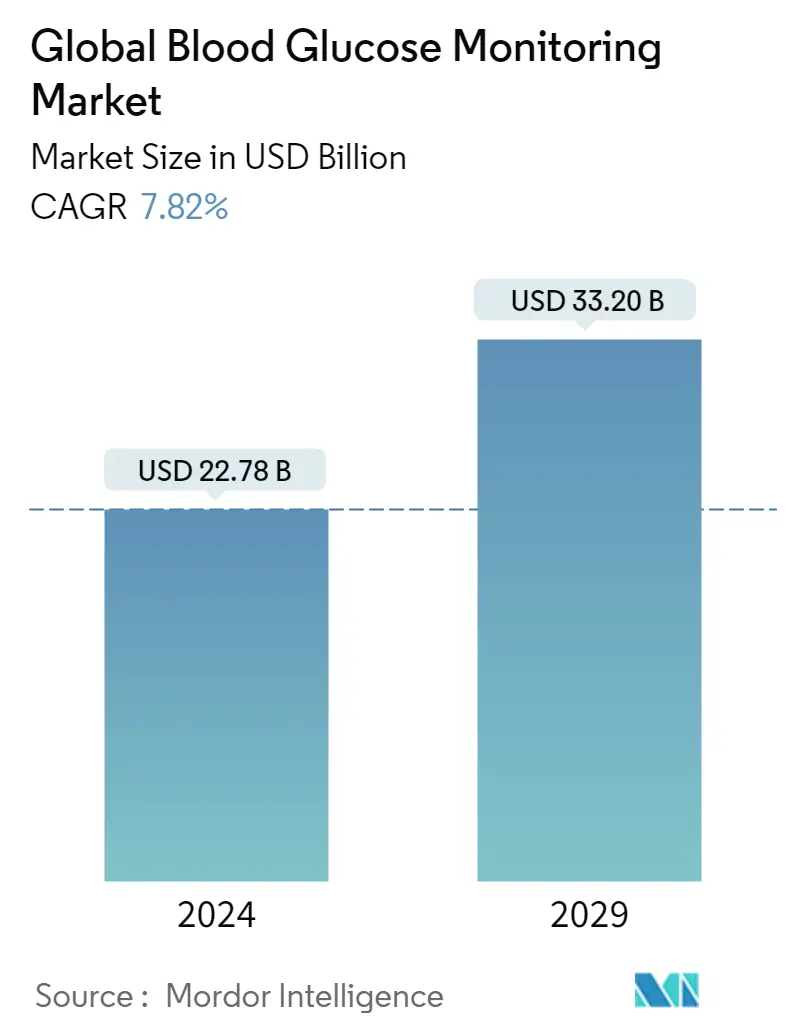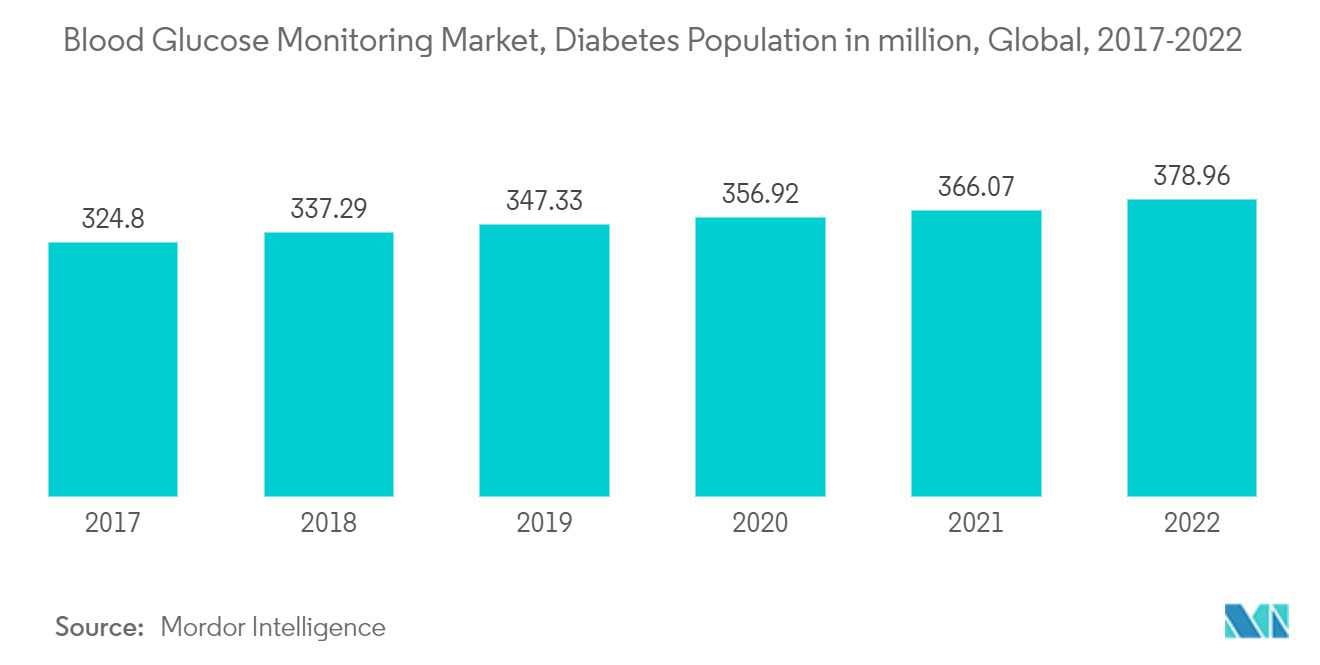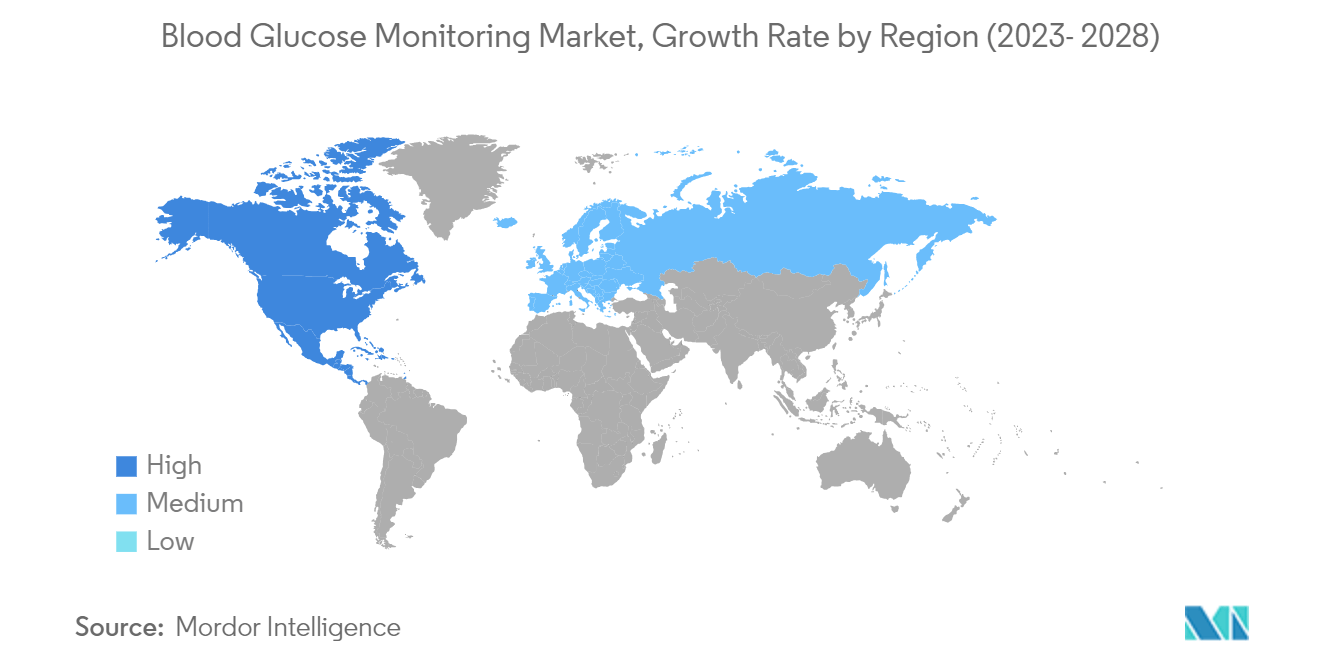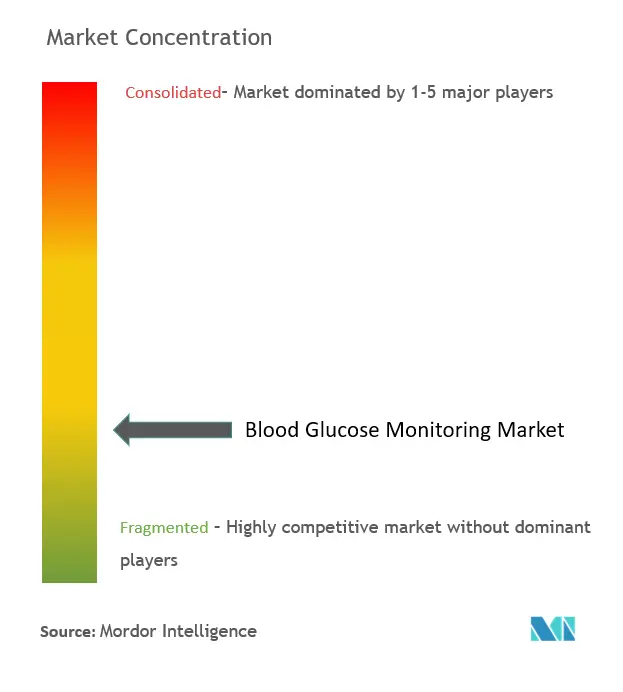Blood Glucose Monitoring Market Size

| Study Period | 2019 - 2029 |
| Market Size (2024) | USD 22.78 Billion |
| Market Size (2029) | USD 33.20 Billion |
| CAGR (2024 - 2029) | 7.82 % |
| Fastest Growing Market | Europe |
| Largest Market | North America |
Major Players
*Disclaimer: Major Players sorted in no particular order |
Blood Glucose Monitoring Market Analysis
The Global Blood Glucose Monitoring Market size is estimated at USD 22.78 billion in 2024, and is expected to reach USD 33.20 billion by 2029, growing at a CAGR of 7.82% during the forecast period (2024-2029).
The COVID-19 pandemic positively impacted the blood glucose monitoring system market growth. Patients with diabetes who were infected with SARS-CoV-2 experienced additional stress and increased secretion of hyperglycemic hormones such as glucocorticoid and catecholamines, which resulted in elevated blood glucose, abnormal glucose variability, and diabetic complications. To avoid aggravation, a patient's blood glucose monitoring had to be considered during the COVID-19 patient's hospitalization, which underlined the importance of blood glucose monitoring devices. The United States Food and Drug Administration also allowed personal blood glucose meters and continuous glucose monitoring devices in hospitals during the pandemic. The pandemic increased remote care from patients and providers and removed many long-standing regulatory barriers.
According to WHO, diabetes is a long-lasting metabolic disorder characterized by high blood glucose (or blood sugar) levels, resulting in severe damage to the heart, blood vessels, eyes, kidneys, and nerves over time. The most prevalent form is Type 2 diabetes, typically occurring in adults, where the body becomes resistant to insulin or fails to produce enough insulin. In the past three decades, the incidence of Type 2 diabetes has significantly increased across countries with varying income levels. Type 1 diabetes, previously referred to as juvenile diabetes or insulin-dependent diabetes, is a chronic condition in which the pancreas produces insufficient or no insulin on its own. For individuals living with diabetes, affordable access to treatment, including insulin, is crucial for their survival. A global target has been established to halt the escalation of diabetes and obesity by 2025.
According to recent estimates published in 2023 by The Lancet, it is projected that over 1·31 billion individuals worldwide could be affected by diabetes by the year 2050. This staggering number represents a significant portion of the global population living with a disease that not only leads to life-altering health complications but also contributes to higher mortality rates and exacerbates various other illnesses. The anticipated increase in diabetes prevalence is primarily driven by the rising incidence of type 2 diabetes. This, in turn, can be attributed to the growing prevalence of obesity and demographic shifts. In the current year, type 2 diabetes accounted for 90% of all diabetes cases. The majority of this burden can be attributed to social risk factors, including high BMI, dietary risks, environmental and occupational hazards, tobacco and alcohol use, and low levels of physical activity. These risk factors thrive due to the obesogenic nature of our environments and the inequitable distribution of resources and societal organization.
Blood glucose monitoring tests the glucose concentration in the blood (glycemia). Particularly important in diabetes management, a blood glucose test is typically performed to determine the fluctuation in blood glucose level to take or alter the medication accordingly, especially for insulin users. Achieving optimum glycemic results can be very difficult without frequent monitoring of blood glucose levels.
Technological advancements in blood glucose meters, including cellular-connected devices that automatically upload SMBG data to secure cloud-based databases, allow for improved sharing and monitoring of SMBG data. Real-time monitoring of SMBG data presents opportunities to provide timely support to patients responding to abnormal SMBG recordings. Such diabetes remote monitoring programs can provide patients with poorly controlled diabetes additional support needed to improve critical outcomes, thereby enhancing the market prospects in the years to come.
Blood Glucose Monitoring Market Trends
The Self-blood Glucose Monitoring Segment held the Highest Market Share in the Current Year
The self-blood glucose monitoring segment held a major market share of about 66.09% in the blood glucose monitoring market in the current year.
Self-monitoring of blood glucose is an approach used by diabetic patients to measure their blood sugar level themselves, using a glucometer, test strips, and lancets. Based on the readings, patients can adjust or check the effect of their treatment. Although CGM is an advanced way for people living with diabetes to check glucose readings in real-time, SMBG is the most preferred device by patients due to its economic affordability and less sophisticated usage when compared to CGM.
The international guidelines suggest that self-monitoring blood glucose (SMBG) should be used regularly for effective diabetes management and treatment. Although there may be discrepancies between glucometer readings and actual blood glucose levels, the immediate results provided by glucometers are more convenient than those obtained through laboratory testing, which can be time-consuming. As a result, SMBG devices have become widely used in medical settings, from patients' homes to hospital emergency rooms.
The growth in market volume and share of test strips are expected to be higher than that of glucose meters because of the difference in use-case frequency. The average efficiency of the glucose meter ranges between six months to three years, whereas test strips are for one-time use. Introducing new kinds of lancet devices that induce lesser pain to the users is expected to help the market’s growth, as the acceptance rate is likely to rise during the forecast period.
Innovative technologies, such as digital health apps that display and summarize individual blood glucose measurements and incorporate additional relevant data, such as insulin doses, meals/snacks, and physical activity, can further support self-management while decreasing disease burden and benefitting overall diabetes care. Integration of Blood Glucose Monitoring with insulin calculators, automated insulin titration software, and remote coaching are further developments that provide patients with poorly controlled diabetes additional support needed to improve critical outcomes, thereby enhancing the market prospects in the years to come.
The market players are adopting various strategies such as collaborations, partnerships, mergers, acquisitions, product development, and expansions to increase market share. For instance, in January 2023, LifeScan announced that the peer-reviewed Journal of Diabetes Science and Technology published Improved Glycemic Control Using a Bluetooth Connected Blood Glucose Meter and a Mobile Diabetes App: Real-World Evidence From Over 144,000 People With Diabetes, detailing results from a retrospective analysis of real-world data from over 144,000 people with diabetes one of the largest combined blood glucose meter and mobile diabetes app datasets ever published.
Thus, the above-mentioned factors are expected to drive the segment growth over the forecast period.

North America Expected to Dominate the Blood Glucose Monitoring Market
In the current year, North America, especially the United States, held the largest share of about 54.5% in the blood glucose monitoring market due to the large patient pool and wide acceptance of advanced technologies, followed by Europe, with moderate growth.
The Centers for Disease Control and Prevention (CDC) National Diabetes Statistics Report 2022 estimated that more than 130 million adults are living with diabetes or prediabetes in the United States. Type 2 diabetes is more common, and diabetes is more consequential among communities of color, those who live in rural areas, and those with less education, lower incomes, and lower health literacy.
The American Diabetes Association (ADA), the Endocrine Society, the American College of Physicians, the American Academy of Pediatrics, the Society of General Internal Medicine, and the National Academy of Medicine published statements. It issued calls to action to address social determinants of health (SDOH) at the individual, organizational, and policy levels. In 2021, the ADA also published a scientific review describing the associations between SDOH and diabetes risk and outcomes, focusing on socioeconomic status, health literacy, the food environment, food insecurity, and neighborhood and physical environments, among other topics.
Furthermore, the current continuous glucose monitoring devices can either retrospectively display the trends in blood glucose levels by downloading the data or give a real-time picture of glucose levels through receiver displays. The newest CGM models, the Abbott Freestyle Libre 3 and the Dexcom G7, overcame many technical barriers. Technological advances such as Eversense E3 CGMs have significantly improved providers' ability to treat diabetes and patients' ability to manage their blood glucose levels.
According to the Centre for Health Care Strategies for Medicaid agencies that can cover and increase access to CGMs for their beneficiaries and the larger healthcare system, there is strong evidence that supports the benefits of CGM use for all people who are insulin-treated with an insulin pump or multiple daily insulin injections, and emerging evidence is showing the benefit of CGMs in patients on basal insulin.
Therefore, owing to the aforementioned factors, the growth of the studied market is anticipated in the North American region.

Blood Glucose Monitoring Industry Overview
The blood glucose monitoring market is moderately fragmented. Companies like Dexcom, Medtronic, Abbott, and Senseonics dominate the CGM devices market. The market for SMBG devices comprises major players like Roche, Sinocare, LifeScan, Arkray, Ascensia, etc., and other generic players. Mergers and acquisitions among the players in the recent past have helped the companies strengthen their market presence.
Blood Glucose Monitoring Market Leaders
-
Abbott Diabetes Care
-
Roche Holding AG
-
Medtronic PLC
-
Dexcom Inc.
-
LifeScan Inc.
*Disclaimer: Major Players sorted in no particular order

Blood Glucose Monitoring Market News
- October 2023: The Canadian government approved Dexcom's next-generation Dexcom G7 Continuous Glucose Monitoring System for Canadian type-1 diabetes patients.
- June 2023: The initial locally-produced continuous glucose monitoring device was granted approval by the South Korean Ministry of Food and Drug Safety. I-SENS, the manufacturer of blood glucose devices, introduced CareSens Air, which claimed to be the most compact and lightweight CGM device accessible in South Korea. Additionally, it has the capability to be utilized continuously for a period of 15 days and incorporates a calibration mechanism to enhance the accuracy of readings.
Global Blood Glucose Monitoring Market Report - Table of Contents
1. INTRODUCTION
- 1.1 Study Assumptions and Market Definition
- 1.2 Scope of the Study
2. RESEARCH METHODOLOGY
3. EXECUTIVE SUMMARY
4. MARKET DYNAMICS
- 4.1 Market Overview
- 4.2 Market Drivers
- 4.3 Market Restraints
-
4.4 Industry Attractiveness - Porter's Five Forces Analysis
- 4.4.1 Bargaining Power of Suppliers
- 4.4.2 Bargaining Power of Consumers
- 4.4.3 Threat of New Entrants
- 4.4.4 Threat of Substitute Products and Services
- 4.4.5 Intensity of Competitive Rivalry
5. MARKET SEGMENTATION
-
5.1 By Device (Revenue and Volume)
- 5.1.1 Self-Monitoring Blood Glucose
- 5.1.1.1 Glucometer Devices
- 5.1.1.2 Test Strips
- 5.1.1.3 Lancets
- 5.1.2 Continuous Glucose Monitoring
- 5.1.2.1 Sensors
- 5.1.2.2 Durables (Receivers and Transmitters)
-
5.2 By End User (Revenue and Volume)
- 5.2.1 Hospital/Clinics Usage
- 5.2.2 Self/Home Usage
-
5.3 By Indicators (Revenue and Volume)
- 5.3.1 Type-1 Diabetes Population
- 5.3.2 Type-2 Diabetes Population
-
5.4 Geography (Revenue and Volume)
- 5.4.1 North America
- 5.4.1.1 By Device, By End User, By Indicators
- 5.4.1.2 By Country
- 5.4.1.2.1 United States
- 5.4.1.2.2 Canada
- 5.4.1.2.3 Rest of North America
- 5.4.2 Europe
- 5.4.2.1 By Device, By End User, By Indicators
- 5.4.2.2 By Country
- 5.4.2.2.1 France
- 5.4.2.2.2 Germany
- 5.4.2.2.3 Italy
- 5.4.2.2.4 Spain
- 5.4.2.2.5 United Kingdom
- 5.4.2.2.6 Russia
- 5.4.2.2.7 Rest of Europe
- 5.4.3 Latin America
- 5.4.3.1 By Device, By End User, By Indicators
- 5.4.3.2 By Country
- 5.4.3.2.1 Mexico
- 5.4.3.2.2 Brazil
- 5.4.3.2.3 Rest of Latin America
- 5.4.4 Asia-Pacific
- 5.4.4.1 By Device, By End User, By Indicators
- 5.4.4.2 By Country
- 5.4.4.2.1 Japan
- 5.4.4.2.2 South Korea
- 5.4.4.2.3 China
- 5.4.4.2.4 India
- 5.4.4.2.5 Australia
- 5.4.4.2.6 Vietnam
- 5.4.4.2.7 Malaysia
- 5.4.4.2.8 Indonesia
- 5.4.4.2.9 Philippines
- 5.4.4.2.10 Thailand
- 5.4.4.2.11 Rest of Asia-Pacific
- 5.4.5 Middle East and Africa
- 5.4.5.1 By Device, By End User, By Indicators
- 5.4.5.2 By Country
- 5.4.5.2.1 Saudi Arabia
- 5.4.5.2.2 Iran
- 5.4.5.2.3 Egypt
- 5.4.5.2.4 Oman
- 5.4.5.2.5 South Africa
- 5.4.5.2.6 Rest of Middle East and Africa
6. MARKET INDICATORS
- 6.1 Type-1 Diabetes population
- 6.2 Type-2 Diabetes population
7. COMPETITIVE LANDSCAPE
-
7.1 COMPANY PROFILES
- 7.1.1 Abbott Diabetes Care
- 7.1.2 Roche Holding AG
- 7.1.3 LifeScan
- 7.1.4 Dexcom Inc.
- 7.1.5 Medtronic PLC
- 7.1.6 Arkray Inc.
- 7.1.7 Ascensia Diabetes Care
- 7.1.8 Agamatrix Inc.
- 7.1.9 Bionime Corporation
- 7.1.10 Acon Laboratories Inc.
- 7.1.11 Medisana AG
- 7.1.12 Trivida Functional Medicine
- 7.1.13 Rossmax International Ltd
- 7.1.14 Sinocare
- 7.1.15 Senseonics
- *List Not Exhaustive
-
7.2 COMPANY SHARE ANALYSIS
- 7.2.1 Self-monitoring Blood Glucose
- 7.2.1.1 Abbott Diabetes Care
- 7.2.1.2 Roche Holding AG
- 7.2.1.3 LifeScan
- 7.2.1.4 Others
- 7.2.2 Continuous Glucose Monitoring Devices
- 7.2.2.1 Abbott Diabetes Care
- 7.2.2.2 Dexcom Inc.
- 7.2.2.3 Medtronic PLC
- 7.2.2.4 Others
8. MARKET OPPORTUNITIES AND FUTURE TRENDS
** Subject To AvailablityBlood Glucose Monitoring Industry Segmentation
Blood glucose monitoring devices are used to diagnose both hyperglycemic and hypoglycemic conditions in diabetic patients. The Report Covers the Blood Glucose Monitoring Devices Market Dynamics & Growth. The Market is Segmented by Device (Self-monitoring Blood Glucose (Glucometer Devices, Test Strips, and Lancets) and Continuous Glucose Monitoring (Sensors and Durables (Receivers and Transmitters)), End User (Hospital/Clinical Usage and Home/Personal Usage), Indicators (Type-1 Diabetes Population and Type-2 Diabetes Population) and by Geography (North America, Europe, Asia-Pacific, Middle East & Africa, and Latin America). The Report Offers the Value (in USD) and Volume (in Units) for the Above Segments.
| By Device (Revenue and Volume) | Self-Monitoring Blood Glucose | Glucometer Devices | |
| Test Strips | |||
| Lancets | |||
| By Device (Revenue and Volume) | Continuous Glucose Monitoring | Sensors | |
| Durables (Receivers and Transmitters) | |||
| By End User (Revenue and Volume) | Hospital/Clinics Usage | ||
| Self/Home Usage | |||
| By Indicators (Revenue and Volume) | Type-1 Diabetes Population | ||
| Type-2 Diabetes Population | |||
| Geography (Revenue and Volume) | North America | By Device, By End User, By Indicators | |
| By Country | United States | ||
| Canada | |||
| Rest of North America | |||
| Geography (Revenue and Volume) | Europe | By Device, By End User, By Indicators | |
| By Country | France | ||
| Germany | |||
| Italy | |||
| Spain | |||
| United Kingdom | |||
| Russia | |||
| Rest of Europe | |||
| Geography (Revenue and Volume) | Latin America | By Device, By End User, By Indicators | |
| By Country | Mexico | ||
| Brazil | |||
| Rest of Latin America | |||
| Geography (Revenue and Volume) | Asia-Pacific | By Device, By End User, By Indicators | |
| By Country | Japan | ||
| South Korea | |||
| China | |||
| India | |||
| Australia | |||
| Vietnam | |||
| Malaysia | |||
| Indonesia | |||
| Philippines | |||
| Thailand | |||
| Rest of Asia-Pacific | |||
| Geography (Revenue and Volume) | Middle East and Africa | By Device, By End User, By Indicators | |
| By Country | Saudi Arabia | ||
| Iran | |||
| Egypt | |||
| Oman | |||
| South Africa | |||
| Rest of Middle East and Africa |
Global Blood Glucose Monitoring Market Research Faqs
How big is the Global Blood Glucose Monitoring Market?
The Global Blood Glucose Monitoring Market size is expected to reach USD 22.78 billion in 2024 and grow at a CAGR of 7.82% to reach USD 33.20 billion by 2029.
What is the current Global Blood Glucose Monitoring Market size?
In 2024, the Global Blood Glucose Monitoring Market size is expected to reach USD 22.78 billion.
Who are the key players in Global Blood Glucose Monitoring Market?
Abbott Diabetes Care, Roche Holding AG, Medtronic PLC, Dexcom Inc. and LifeScan Inc. are the major companies operating in the Global Blood Glucose Monitoring Market.
Which is the fastest growing region in Global Blood Glucose Monitoring Market?
Europe is estimated to grow at the highest CAGR over the forecast period (2024-2029).
Which region has the biggest share in Global Blood Glucose Monitoring Market?
In 2024, the North America accounts for the largest market share in Global Blood Glucose Monitoring Market.
What years does this Global Blood Glucose Monitoring Market cover, and what was the market size in 2023?
In 2023, the Global Blood Glucose Monitoring Market size was estimated at USD 21.13 billion. The report covers the Global Blood Glucose Monitoring Market historical market size for years: 2019, 2020, 2021, 2022 and 2023. The report also forecasts the Global Blood Glucose Monitoring Market size for years: 2024, 2025, 2026, 2027, 2028 and 2029.
Who is the target market for blood glucose meters?
The target market for blood glucose meters includes hospitals, diagnostic centers, home health care agencies, medical schools, and teaching hospitals.
Which is the leading segment in the Blood Glucose Monitoring Market?
The leading segment in the Blood Glucose Monitoring Market is Self-Monitoring Blood Glucose (SMBG).
Global Blood Glucose Monitoring Industry Report
The Blood Glucose Monitoring Devices Market Dynamics & Growth report provides a comprehensive industry analysis, offering an in-depth market overview and market analysis. The market is segmented by device, end-user, indicators, and geography, covering North America, Europe, Asia-Pacific, Middle East & Africa, and Latin America. The report includes valuable industry information such as market size, market share, and market trends.
The market forecast highlights the expected market growth, driven by increasing demand for both self-monitoring blood glucose devices and continuous glucose monitoring systems. The report also details the market segmentation by type-analysis, modality basis, and component analysis, providing insights into the growth rate of various segments.
Industry reports indicate a significant market outlook for blood glucose monitoring devices, with market leaders driving innovation and adoption. The industry outlook suggests robust industry growth, supported by market data and market predictions. The market review covers the industry statistics and industry size, emphasizing the importance of market research and industry research in understanding market dynamics.
The report example and report pdf provide detailed market value and market segmentation, essential for stakeholders to make informed decisions. Research companies contribute to the industry trends and industry sales analysis, ensuring a comprehensive understanding of the market landscape.



